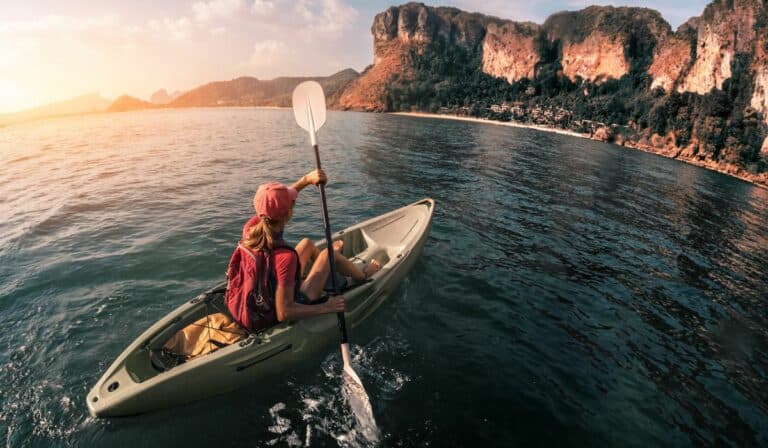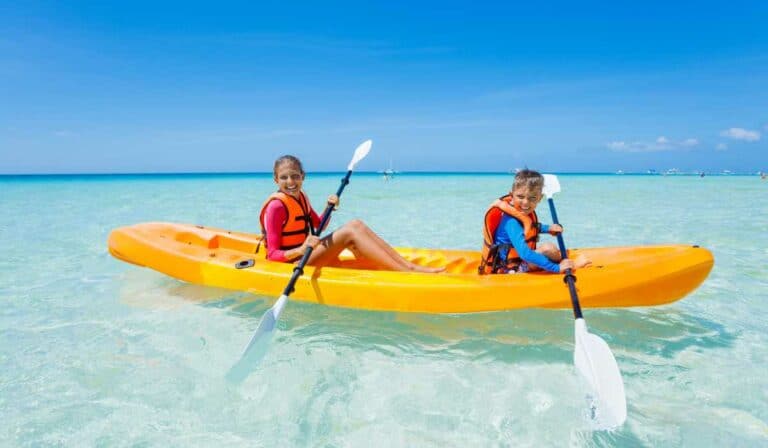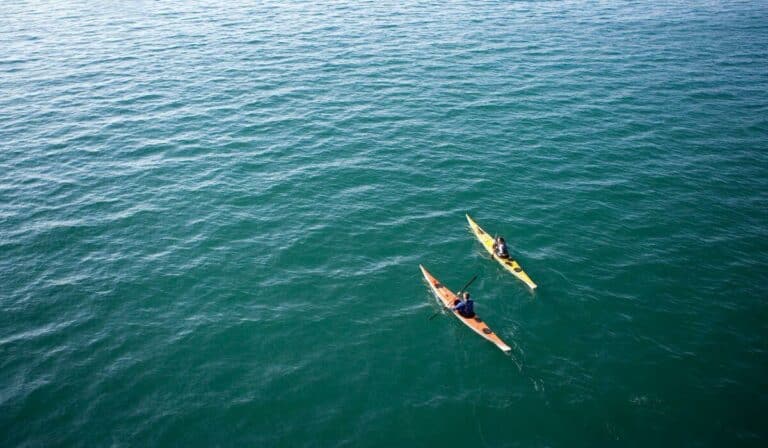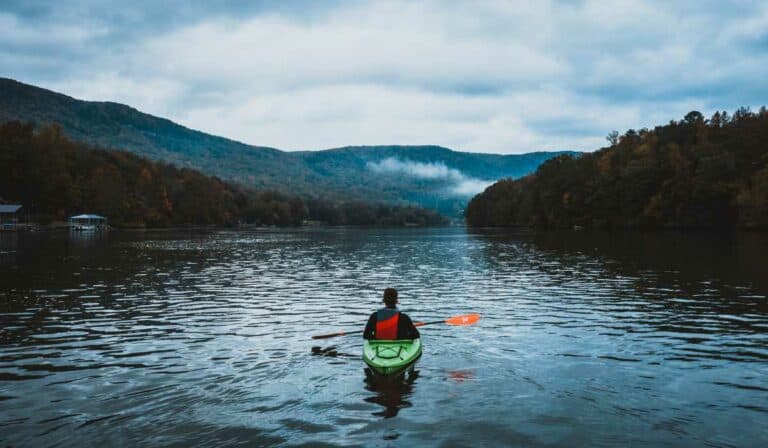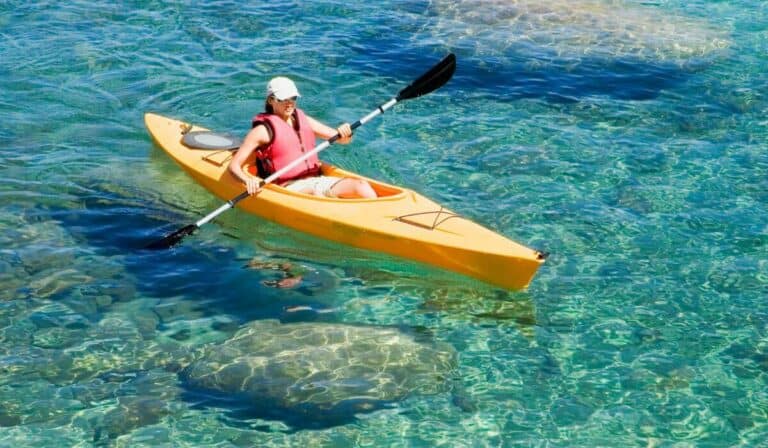Ultimate Guide to Kayak Camping: Tips, Gear & Spots
Are you an outdoor enthusiast looking for a new adventure? Have you considered kayak camping or canoe camping? For those seeking an outdoor adventure, this blog post will provide a comprehensive guide to planning and executing a successful kayak or canoe camping trip.
You’ll learn about the essential gear needed for remote campsites, including sleeping bags, sleeping pads, and dry bags. We’ll also cover how to prepare for cold water and rough water conditions that may arise during longer trips.
No matter your level of kayaking proficiency, this guide will equip you with the knowledge to embark on a thrilling outdoor adventure. So pack your gear and get ready for an unforgettable experience in the great outdoors!
Table of Contents
Choosing the Right Kayak for Camping

When selecting a kayak for camping, size and weight capacity should be taken into account to ensure it is suitable for the journey. Size is an important factor; too big and you won’t be able to carry it far, but too small and you’ll find yourself cramped up with no room for gear.
Weight capacity is also important; make sure your boat can handle all of your supplies plus any extra passengers that might join in on the adventure. Lastly, features like rod holders or storage compartments should be taken into account as well – these will come in handy during those long days out on the water.
The type of kayak you opt for will be largely contingent on your camping destination. If you’re heading out onto open water, then a sit-on-top kayak with plenty of space and stability would work best. For rivers and streams, however, a smaller craft such as an inflatable or whitewater model could provide better maneuverability around obstacles like rocks or logs. No matter which type of kayak you go with though, make sure it has enough storage space for all your necessary items including food, drinks, and camping equipment.
It’s also wise to invest in quality accessories when purchasing a new kayak for camping trips. Paddles are essential – look for ones made from lightweight materials like aluminum or carbon fiber so they don’t weigh down your vessel unnecessarily – while life jackets are mandatory safety items even if swimming isn’t part of the plan. A dry bag can help keep items safe from splashes while other helpful add-ons may include anchor kits or trolling motors depending on how deep into nature you want to explore by kayak.
When selecting a kayak for camping, weight limit and storage space should be taken into account. When selecting a kayak for camping, one should not only consider factors such as weight capacity and storage space but also plan to bring the necessary supplies for an enjoyable outing.
Key Takeaway: When selecting the appropriate kayak for camping, consider both size and weight capacity. Make sure you have all the necessary gear like paddles, life jackets, and dry bags as well; then get ready to hit the open water or tackle some tight rivers.
Packing Essentials for Kayak Camping

When packing for a kayak camping trip, it’s important to remember the basics: food and water, shelter, clothing, safety gear, and navigation tools. Don’t forget Kayak Lights for Long Distance Paddling.
For a more pleasurable excursion, certain additional items should be taken into account. Here are some of the essentials you should consider bringing on your next kayaking adventure.
Pack nourishment that won’t spoil the entire journey. Pack lightweight snacks like granola bars or trail mix as well as meals that require minimal preparation such as instant oatmeal or dehydrated soup mixes. Don’t forget plenty of water; bring at least two gallons per person for each day you plan to be out on the water.
Shelter:
A lightweight tent is essential if you plan on spending multiple nights in one spot along with a sleeping bag rated for cooler temperatures than what you expect during your trip – after all, nighttime can get chilly even in warm climates. If space allows, consider bringing an inflatable mattress pad for extra comfort while sleeping outdoors.
Clothing:
Dress appropriately by layering clothes so that you can easily adjust depending on temperature changes throughout the day and night. Bring waterproof pants and jackets in case of rain showers or splashing waves while paddling through choppy waters – these will keep you dry no matter how wet things get. Also, pack hats (for sun protection) and gloves (to protect against cold weather).
Safety Gear:
Safety first. Make sure to bring life vests/personal flotation devices (PFDs) with whistle attachments in case someone falls overboard into deep waters; they could save lives. It’s also wise to carry a first aid kit containing basic supplies such as bandages, antiseptic wipes, and medications like ibuprofen just in case someone gets injured during the excursion. Additionally, don’t forget sunscreen—even when it’s cloudy outside UV rays can still damage skin over time without proper protection from SPF lotion or spray.
Navigation Tools:
Map reading skills are essential when exploring new places via kayak – make sure everyone has their map book before embarking on any journey so they know where they’re going at all times. Additionally, bring a compass along too; this will help ensure accurate navigation if GPS signals aren’t available due to remote locations or poor cell phone reception areas near bodies of water like rivers or lakeside campsites away from civilization’s reach entirely.
Packing the right essentials for kayak camping is essential to having a successful and enjoyable trip. Time to contemplate the most efficient way of establishing a camp while afloat.
Key Takeaway: Before embarking on a kayaking camping journey, ensure you are adequately outfitted with nourishment and hydration supplies, protective equipment such as tents or sleeping bags plus apparel for layering in the event of temperature shifts. Don’t forget to bring safety gear such as life vestsPFDs with whistles attached and navigation tools including maps and compasses so that everyone can stay safe while exploring the great outdoors.
Setting Up Camp on the Water

When it comes to kayak camping, setting up camp on the water can be a challenge. For a successful and secure kayak camping trip, it is important to consider several elements.
Identifying an appropriate location is key; a place that protects from the wind and water to keep your tent secure and dry. Look for areas with shallow water and natural barriers like islands or points of land that will help protect you from strong winds. Ensure there is sufficient room for all your items, such as the kayak, tent, and other equipment.
Anchoring Your Kayak:
Once you’ve found a good spot, anchor your kayak by tying it off to something sturdy like a tree or rock formation nearby. This will keep your boat secure while you set up camp on shore or in the water if conditions allow it. You may also want to consider bringing along extra rope just in case.
When it comes to camping near water, always play it safe by elevating tents and sleeping bags as far off the ground as possible – either on higher terrain or with poles/stakes if needed – particularly when you’re camped close to shorelines where a sudden rise in water could be an issue.
Also, bear (no pun intended) in mind what type of wildlife might inhabit the area before bedding down for the night; animals like bears can present potential threats so make sure you know your surroundings beforehand (if feasible).
Moreover, never leave food out unguarded; store all snacks securely inside airtight containers away from the campsite while not being used. Keywords: Camping, Water, Elevate Tents & Sleeping Bags, Higher Terrain / Poles / Stakes, Shoreline Flood Risk Awareness, Wildlife Inhabit Area Knowledge, Secure Food Storage
Kayaking can provide thrilling escapades, yet it is vital to ensure safety while partaking in such activities. With these tips in mind – finding the right spot, anchoring your kayak securely, and setting up camp safely – you can enjoy time spent outdoors without worry.
Setting up camp on the water is an exciting and rewarding experience that allows you to get closer to nature. Exploring nature by kayak takes this connection even further, allowing for a truly unique adventure.
Key Takeaway: When kayak camping, it’s essential to find a sheltered spot that is protected from wind and waves, anchor your boat securely in place, and set up camp safely with an awareness of the potential flood risk near shorelines. By following these tips you can enjoy a stress-free outdoor experience.
Exploring Nature by Kayak

Kayaking is an ideal way to observe the natural world and savor outdoor activities. It’s easy to learn, doesn’t require much equipment, and can be done alone or with friends. When you kayak, you get up close and personal with the beauty of nature while also getting a good workout. There are plenty of activities that can be enjoyed while out on the water in your kayak, so let’s take a look at some of them.
Fishing is one popular activity for kayakers. Whether it’s freshwater or saltwater fishing, many different types of fish can be caught from a kayak. With the right gear such as rods, reels, lures, and bait you’ll have no problem catching dinner or just enjoying an afternoon spent angling from your boat.
Bird-watching is another activity that can easily be done from your kayak. Bringing along a pair of binoculars will allow you to observe various bird species such as ducks, geese, and potentially even bald eagles. Not only will this give you something to do during your trip but it’s also educational too – learning about different species never gets old.
Exploring nearby islands or shorelines is yet another great way to spend time on the water in your kayak. This could mean paddling around small islands offshore or heading downriver into unknown territory where who knows what awaits? You may find yourself surrounded by wildlife like otters playing near their den or seals basking in the sun – either way, it makes for quite an adventure.
Lastly don’t forget about camping overnight when out on your next Kayaking excursion – this gives you more time to enjoy all these activities plus provides ample opportunity for stargazing under clear night skies which should not be missed.
Just make sure to bring along all necessary supplies such as food/drink provisions plus warm clothing since temperatures tend to drop after dark when out on open waters.
No matter what type of outdoor enthusiast you are – whether it’s fishing, birdwatching, or exploring new places by riverways – kayaking has something for everyone. So why not grab a paddle today and see what Mother Nature has in store?
Exploring nature by kayak is an exciting way to experience the outdoors and get close to wildlife. Discovering which kayak camping destination is perfect for you is a thrilling journey.
Key Takeaway: Kayaking provides a unique opportunity to immerse yourself in the natural world, from angling and avian observation to traversing isles. With the right gear, you can even camp overnight for some star-gazing under clear night skies. So get out there and see what Mother Nature has in store.
Best Spots in the US For Kayak Camping
For those who wish to immerse themselves in the wonders of nature, kayak camping offers a unique opportunity to explore and appreciate its beauty from the water. Choosing the perfect spot for your kayak camping trip can be a difficult task, given all of the stunning locations across America. Here are some of our top picks for kayaking and camping destinations across America:
1) The Everglades National Park, Florida:
This beautiful park is known for its stunning wildlife, including alligators, turtles, dolphins, and manatees. There are plenty of paddling trails through this wetland paradise that will take you past hidden islands with secluded beaches perfect for setting up camp. Plus, there’s always something new to discover.
2) Lake Tahoe Basin Management Unit (LTBMU), California/Nevada:
If you’re looking for an adventure-filled lake escape then look no further than LTBMU. Spanning both sides of the border between California and Nevada, this lake offers crystal clear waters ideal for fishing or exploring by kayak. Camping sites line the shoreline offering picturesque views over the lake during sunset or sunrise.
3) Apostle Islands National Lakeshore (AINL), Wisconsin:
Located off the northern coast of Wisconsin in Lake Superior lies AINL; a cluster of 21 islands filled with breathtaking sea caves ready to be explored by kayakers who brave its chilly waters. Onshore campsites provide access to some incredible hiking trails as well as stunning views over land and sea alike – making it one unforgettable outdoor experience.
For those seeking a daring outdoor adventure, the Ozark National Scenic Riverways (ONSR) in Missouri is the perfect destination. Stretching along 135 miles of pristine riverbanks, this area offers countless opportunities for exploration – from paddling down rapids to fishing and swimming at designated spots.
With campsites conveniently scattered throughout, you can easily make your way back into town after an exciting day spent on the water. So, prepare yourself for an extraordinary outdoor experience and explore the Ozark National Scenic Riverways in Missouri. Keywords: Outdoor Adventure, Ozark National Scenic Riverways (ONSR), Missouri, Paddling Down Rapids, Fishing & Swimming Spots, Campsites
No matter what type of outdoor enthusiast you may be, these four US locations offer something special when it comes to combining camping with kayaking adventures. They allow you to explore and enjoy yourself safely at the same time. So why not grab your gear today and plan your outdoor expedition?
The Idea: For the outdoor adventurer, kayak camping offers an exciting opportunity to explore America’s stunning natural beauty. From exploring Everglades National Park in Florida to discovering hidden sea caves in Wisconsin’s Apostle Islands, these four locations provide a thrilling combination of paddling down rapids and setting up camp along riverbanks or secluded beaches – perfect for anyone looking for their next adventure.
FAQs about Kayak Camping
What do I need to know about kayak camping?
Combining kayaking with camping activities such as setting up camp, cooking meals, and sleeping in a tent creates an exciting outdoor experience. To ensure safety while kayaking camping, it’s important to know how to properly pack gear for transport on your kayak, secure items from getting wet or lost overboard, and plan for possible weather changes and emergencies that may arise during your trip. Be aware of any laws or regulations in the area to guarantee a secure and pleasant time while out on the water.
Why is kayaking so relaxing?
Gliding across the water in a kayak can be a peaceful respite from the stresses of daily life, providing an opportunity to appreciate nature’s beauty and reflect.
The rhythmic, soothing action of rowing brings a tranquilizing effect, enabling your brain to drift off while you take in the scenery around you. Kayaking also offers great exercise while providing a low impact on joints, making it ideal for those with physical limitations or injuries.
Lastly, kayakers can explore remote areas that are inaccessible by car or foot – giving them access to stunning views and unique experiences they wouldn’t find anywhere else.
What are the benefits of kayaking?
For those seeking an adventure, kayaking is a perfect way to immerse oneself in nature while also enjoying the physical benefits of increased strength, balance, coordination, and endurance.
It can provide an adrenaline rush, while also allowing you to take in the beautiful scenery. Kayaking offers physical benefits such as improved strength, balance, coordination, and endurance. Additionally, it has mental health benefits including stress relief and increased focus due to its calming nature.
Furthermore, kayaking allows you to connect with nature through direct contact with water and wildlife which can help reduce anxiety levels. In summary, kayaking is an enjoyable way to commune with nature.
Am I too fat to kayak?
No, you are not too fat to kayak. Regardless of physique, kayaking is an accessible pastime for anyone with the right boat size, paddling technique and safety equipment.
The correct size vessel, in addition to the appropriate paddling approach and protective gear, is vital for kayaking regardless of your physique. With these considerations in mind, anyone can enjoy this exciting outdoor activity.
Conclusion
Kayak camping is an amazing way to explore nature and get away from the hustle and bustle of everyday life. Take a break from your hectic lifestyle and revel in the beauty of nature by going kayak camping.
With the right gear, preparation, and knowledge about kayak camping, you can make your next outdoor adventure unforgettable. So don’t wait any longer – grab your paddleboard or kayak now for a unique experience on the water with kayak camping.
Join us on SunWaterDirt.com for the best tips and tricks to make your next kayak camping adventure unforgettable! Get all of the information you need from our expert team of outdoor adventurers today.



